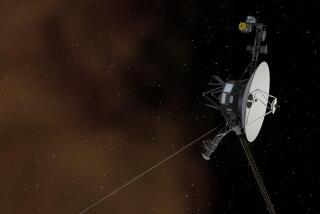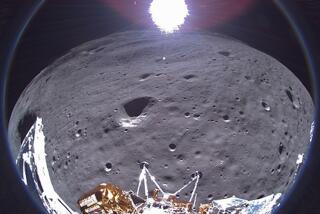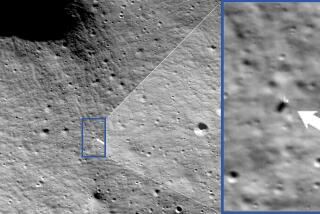Second Rover Gets Ready to Roll
NASA’s Opportunity rover rose up and stretched its legs overnight Tuesday, deploying its front wheels in preparation for rolling onto the Martian surface Sunday evening.
Repairs on its twin sister Spirit are proceeding well, and the craft should resume its scientific work next week, officials at NASA’s Jet Propulsion Laboratory in Pasadena said Wednesday.
Opportunity, which landed Saturday on Mars, was scheduled to complete its stand-up early today, extending its rear wheels and locking them into place to prepare for severing its connections with the lander.
The craft is performing “flawlessly,” said Rick Welch, who is in charge of the stand-up procedures.
The team has encountered one minor problem with the rover. A small heater at a joint in the arm that operates the craft’s thermal emission spectrometer is turning on whenever the temperature drops outside. That should not happen when the arm is stowed away.
The heater produces a small electrical drain on the rover’s batteries, but “it is not affecting us at all,” Welch said. “We are not concerned about having this heater on.”
The team wants to adjust the lander’s position slightly before Opportunity tries to drive off it. The lander is tilted backward about 4 degrees to 5 degrees. Mission controllers would prefer that it tilted forward by about the same amount, making it easier for the rover to roll off.
Welch said the team would retract the air bags in the rear more, then use the lander’s rear petal to press down on them in an effort to lift the rear.
Opportunity sent back color pictures showing part of its surroundings, including a nearby rock outcropping. “We continue to get some spectacular images, and we are having a lot of fun arguing, debating and hypothesizing about their meaning,” said Jim Bell of Cornell University, who developed the craft’s cameras.
Several images showed the round spots where the rover bounced on its air bags as it came to rest inside a crater in Meridiani Planum. The high-definition pictures show imprints of the straps and other structural details of the bags.
“The marks are telling us something about the physical properties of the soil,” Bell said. The impressions suggest that the soil is composed of very fine-grained materials, much like kitchen flour, but none of the soil has stuck to the air bags like it did with Spirit.
Geologists hope to examine the imprints as Opportunity begins its surface wanderings. As the lander bounced to a stop, it traced a figure-eight in the crater, Bell said, “so we will encounter them whichever way we go.”
Engineers are working to resurrect Spirit, which has been stranded on the other side of Mars for a week because of a computer malfunction.
The team has traced the problem to the inability of Spirit’s computer to manage the large number of data files contained in the craft’s flash memory, which is used for short-term storage of data much like the memory cards in a digital camera.
The team had a hard time tracing the sequence of events that led to the shutdown because Spirit has been communicating through its low-gain antenna, which has a very low transmission rate. But officials said late Wednesday that they had the high-gain antenna working again, which will allow them to read the contents of the flash memory.
Using the antenna, Spirit sent back a new picture, the first since its malfunction a week ago. The photograph shows the arm of the rover holding a spectrometer against the rock called Adirondack.
“Everything is right where we left it,” said Mark Adler, one of the mission managers.
Another manager, Jennifer Trosper, said they would begin “surgically” deleting some of the files in the flash memory. If that doesn’t solve the problem, they will wipe the flash memory clean and start over. Spirit landed on Mars on Jan. 3.
NASA officials announced they were naming three of the hills at Spirit’s Gusev Crater landing site after the crew of Apollo 1, who died in a fire during a launchpad test 37 years ago Tuesday. The members of the crew were Gus Grissom, Ed White and Roger Chaffee.
The agency said it would name Opportunity’s landing site the Challenger Memorial Station, in honor of the shuttle that exploded on takeoff in 1986.
NASA earlier had named Spirit’s landing site the Columbia Memorial Station, in honor of the shuttle that was destroyed last year during reentry.
More to Read
Sign up for Essential California
The most important California stories and recommendations in your inbox every morning.
You may occasionally receive promotional content from the Los Angeles Times.










